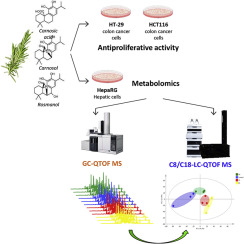当前位置:
X-MOL 学术
›
Anal. Chim. Acta
›
论文详情
Our official English website, www.x-mol.net, welcomes your
feedback! (Note: you will need to create a separate account there.)
Metabolomics study of early metabolic changes in hepatic HepaRG cells in response to rosemary diterpenes exposure
Analytica Chimica Acta ( IF 5.7 ) Pub Date : 2018-12-01 , DOI: 10.1016/j.aca.2017.12.006 Tanize Acunha , Virginia García-Cañas , Alberto Valdés , Alejandro Cifuentes , Carolina Simó
Analytica Chimica Acta ( IF 5.7 ) Pub Date : 2018-12-01 , DOI: 10.1016/j.aca.2017.12.006 Tanize Acunha , Virginia García-Cañas , Alberto Valdés , Alejandro Cifuentes , Carolina Simó

|
Rosemary diterpenes have demonstrated diverse biological activities, such as anti-cancer, antiinflammatory, as well as other beneficial effects against neurological and metabolic disorders. In particular, carnosic acid (CA), carnosol (CS) and rosmanol (RS) diterpenes have shown interesting results on anti-cancer activity. However, little is known about the toxic effects of rosemary diterpenes at the concentrations needed to exert their antiproliferative effect on cancer cells. In our study, CA, CS and RS exhibited a concentration-dependent effect on cell viability of two human colon cancer cell lines (HT-29 and HCT116) after 24 h exposure. HT-29 cell line was more resistant to the inhibitory effect of the three diterpenes than HCT116 cell line. Among the three diterpenes, RS exerted the strongest effect in both cell lines. To investigate the hepatotoxicity of CA, CS and RS, undifferentiated and differentiated HepaRG cells were exposed to increasing concentrations of the diterpenes (from 10 to 100 μM). Differentiated cells were found to be more resistant to the toxic activity of the three diterpenes than undifferentiated HepaRG, probably related to a higher detoxifying function of differentiated HepaRG cells compared with the undifferentiated cells. The metabolic profiles of differentiated HepaRG cells in response to CA, CS and RS were examined to determine biochemical alterations and deepen the study of the effects of rosemary phenolic diterpenes at molecular level. A multiplatform metabolomics study based on liquid- and gas-chromatography hyphenated to high resolution mass spectrometry revealed that rosemary diterpenes exerted different effects when HepaRG cells were treated with the same concentration of each diterpene. RS revealed a greater metabolome alteration followed by CS and CA, in agreement with their observed cytotoxicity. Metabolomics provided valuable information about early events in the metabolic profiles after the treatment with the investigated diterpenes from rosemary.
中文翻译:

迷迭香二萜暴露对肝脏 HepaRG 细胞早期代谢变化的代谢组学研究
迷迭香二萜已证明具有多种生物活性,例如抗癌、抗炎以及对神经和代谢紊乱的其他有益作用。特别是,鼠尾草酸 (CA)、鼠尾草酚 (CS) 和迷迭香酚 (RS) 二萜在抗癌活性方面显示出有趣的结果。然而,关于迷迭香二萜在对癌细胞发挥抗增殖作用所需的浓度下的毒性作用知之甚少。在我们的研究中,CA、CS 和 RS 在暴露 24 小时后对两种人结肠癌细胞系(HT-29 和 HCT116)的细胞活力表现出浓度依赖性影响。HT-29细胞系比HCT116细胞系对三种二萜的抑制作用更具抵抗力。在三种二萜中,RS 在两种细胞系中发挥的作用最强。为了研究 CA、CS 和 RS 的肝毒性,未分化和分化的 HepaRG 细胞暴露于浓度不断增加的二萜(从 10 到 100 μM)。发现分化的细胞比未分化的 HepaRG 对三种二萜的毒性活性更具抵抗力,这可能与分化的 HepaRG 细胞与未分化细胞相比具有更高的解毒功能有关。检查了响应 CA、CS 和 RS 的分化 HepaRG 细胞的代谢特征,以确定生化改变并在分子水平上加深对迷迭香酚二萜作用的研究。一项基于液相和气相色谱与高分辨率质谱联用的多平台代谢组学研究表明,当用相同浓度的每种二萜处理 HepaRG 细胞时,迷迭香二萜发挥不同的作用。RS 揭示了更大的代谢组改变,其次是 CS 和 CA,与其观察到的细胞毒性一致。代谢组学提供了有关迷迭香中研究的二萜处理后代谢谱中早期事件的宝贵信息。
更新日期:2018-12-01
中文翻译:

迷迭香二萜暴露对肝脏 HepaRG 细胞早期代谢变化的代谢组学研究
迷迭香二萜已证明具有多种生物活性,例如抗癌、抗炎以及对神经和代谢紊乱的其他有益作用。特别是,鼠尾草酸 (CA)、鼠尾草酚 (CS) 和迷迭香酚 (RS) 二萜在抗癌活性方面显示出有趣的结果。然而,关于迷迭香二萜在对癌细胞发挥抗增殖作用所需的浓度下的毒性作用知之甚少。在我们的研究中,CA、CS 和 RS 在暴露 24 小时后对两种人结肠癌细胞系(HT-29 和 HCT116)的细胞活力表现出浓度依赖性影响。HT-29细胞系比HCT116细胞系对三种二萜的抑制作用更具抵抗力。在三种二萜中,RS 在两种细胞系中发挥的作用最强。为了研究 CA、CS 和 RS 的肝毒性,未分化和分化的 HepaRG 细胞暴露于浓度不断增加的二萜(从 10 到 100 μM)。发现分化的细胞比未分化的 HepaRG 对三种二萜的毒性活性更具抵抗力,这可能与分化的 HepaRG 细胞与未分化细胞相比具有更高的解毒功能有关。检查了响应 CA、CS 和 RS 的分化 HepaRG 细胞的代谢特征,以确定生化改变并在分子水平上加深对迷迭香酚二萜作用的研究。一项基于液相和气相色谱与高分辨率质谱联用的多平台代谢组学研究表明,当用相同浓度的每种二萜处理 HepaRG 细胞时,迷迭香二萜发挥不同的作用。RS 揭示了更大的代谢组改变,其次是 CS 和 CA,与其观察到的细胞毒性一致。代谢组学提供了有关迷迭香中研究的二萜处理后代谢谱中早期事件的宝贵信息。











































 京公网安备 11010802027423号
京公网安备 11010802027423号